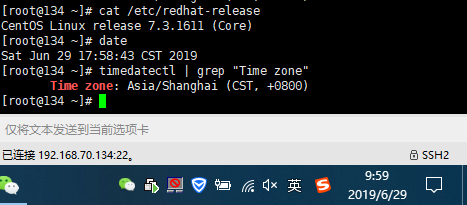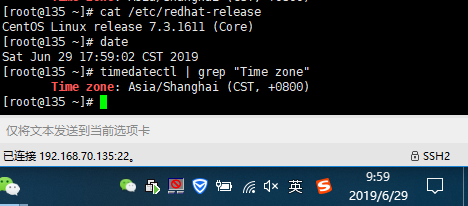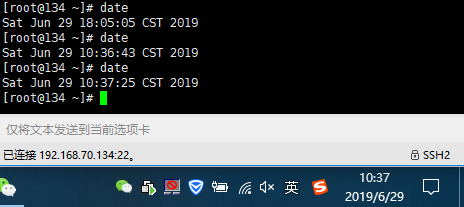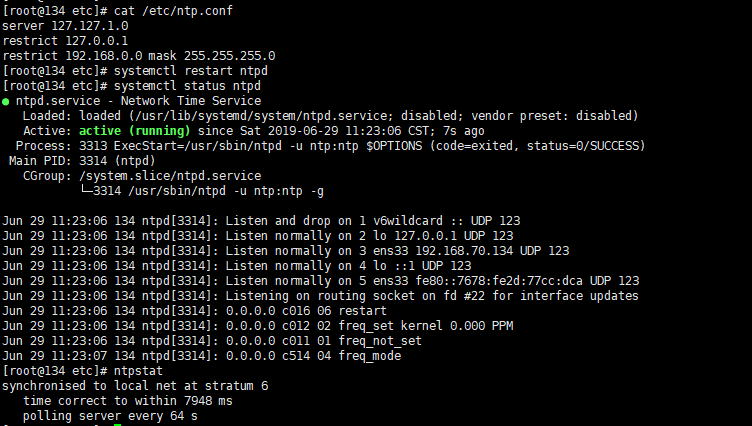NTP (Network Time Protocol)
作用:将网络中的各个主机的时间进行同步,局域网中的误差<0.1ms
架构:C/S
实验环境:两台有网络的Centos,其中134为服务端,135为客户端。134同步网络时间,其他服务器同步134时间。
1、查看134的系统信息、时间和时区
cat /etc/redhat-release
date
timedatectl | grep "Time zone"
此时可以看到134时区为上海、时间和网络时间不同步
2、查看135的系统信息、时间和时区
cat /etc/redhat-release
date
timedatectl | grep "Time zone"
此时可以看到135时区为上海、时间和网络时间不同步
3、在服务端134编写计划任务设置服务器自动同步阿里云时间服务器,并把本地时间同步到硬件时间。
4、此时查看服务器134的时间,已经和网络时间同步
5、在服务端134安装ntp服务,需要有yum源。(配置yum源 https://blog.51cto.com/14015577/2414577)
yum install ntp -y
6、配置服务器端134
NTP配置文件介绍
/etc/ntp.conf
内容:
(1)、restrict:指定授权哪些主机可以使用ntp进行时间同步
格式:restrict IP地址 mask 子网掩码 参数
参数:ignore:关闭ntp服务器
nomodify:指定客户端可以进行时间同步,但是不能修改服务器端时间
例子:
restrict 192.168.6.123
restrict 192.168.6.0 mask 255.255.255.0
restrict 0.0.0.0 mask 0 0 0 0 nomodify
( 2)、server:指定从哪个外部时间服务器来获取时间
例子:
server 0.centos.pool.ntp.org iburst
server 1.centos.pool.ntp.org iburst
server 2.centos.pool.ntp.org iburst
server 3.centos.pool.ntp.org iburst
8、客户端134编写计划任务自动同步135服务器上的时间,并把时间同步到硬件时间
crontab -l
作用:将网络中的各个主机的时间进行同步,局域网中的误差<0.1ms
架构:C/S
实验环境:两台有网络的Centos,其中134为服务端,135为客户端。134同步网络时间,其他服务器同步134时间。
1、查看134的系统信息、时间和时区
cat /etc/redhat-release
date
timedatectl | grep "Time zone"

此时可以看到134时区为上海、时间和网络时间不同步
2、查看135的系统信息、时间和时区
cat /etc/redhat-release
date
timedatectl | grep "Time zone"

此时可以看到135时区为上海、时间和网络时间不同步
3、在服务端134编写计划任务设置服务器自动同步阿里云时间服务器,并把本地时间同步到硬件时间。
-
-
-
-
- /usr/sbin/ntpdate -u ntp1.aliyun.com &>/dev/null
-
-
-
-
-
-
-
- /usr/sbin/hwclock -w &>/dev/null
-
-
-

4、此时查看服务器134的时间,已经和网络时间同步

5、在服务端134安装ntp服务,需要有yum源。(配置yum源 https://blog.51cto.com/14015577/2414577)
yum install ntp -y

6、配置服务器端134
NTP配置文件介绍
/etc/ntp.conf
内容:
(1)、restrict:指定授权哪些主机可以使用ntp进行时间同步
格式:restrict IP地址 mask 子网掩码 参数
参数:ignore:关闭ntp服务器
nomodify:指定客户端可以进行时间同步,但是不能修改服务器端时间
例子:
restrict 192.168.6.123
restrict 192.168.6.0 mask 255.255.255.0
restrict 0.0.0.0 mask 0 0 0 0 nomodify
( 2)、server:指定从哪个外部时间服务器来获取时间
例子:
server 0.centos.pool.ntp.org iburst
server 1.centos.pool.ntp.org iburst
server 2.centos.pool.ntp.org iburst
server 3.centos.pool.ntp.org iburst
此时134配置如下:
server 127.127.1.0
restrict 127.0.0.1
restrict 192.168.0.0 mask 255.255.255.0
启动ntp服务并查看状态
systemctl restart ntpd
systemctl status ntpd
ntpstat

7、客户端135安装ntpdate服务
yum install ntpdate -y

8、客户端134编写计划任务自动同步135服务器上的时间,并把时间同步到硬件时间
crontab -l
-
-
-
-
- /usr/sbin/ntpdate -u 192.168.70.134 &>/dev/null
-
-
-
-
-
-
-
- /usr/sbin/hwclock -w &>/dev/null
-
-
-

版权声明:本文内容由互联网用户自发贡献,该文观点与技术仅代表作者本人。本站仅提供信息存储空间服务,不拥有所有权,不承担相关法律责任。如发现本站有涉嫌侵权/违法违规的内容, 请发送邮件至 dio@foxmail.com 举报,一经查实,本站将立刻删除。




